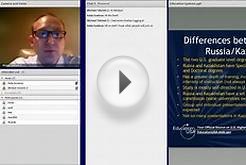The system of education in the U.S. is unlike those in Europe or Asia or South America in one simple way: the United States has no central Ministry of Education. This is the defining feature of U.S. higher education. It is why we have the best universities in the world (by pretty much any measure), and it is also why applying to U.S. colleges and universities can be so confusing.
We do have a Department of Education, but it is by far the smallest federal department. It doesn’t run schools or universities. It doesn’t issue diplomas. It doesn’t write or choose curricula. So each college or university decides for itself how best to teach its students.
This leads to the first great strength of U.S. higher education—diversity. With over 4, 000 accredited colleges and universities, the U.S. system provides so many learning options that virtually all students can study what they want in a way that works for them.
Let me give an example. Though most colleges teach math and science traditionally, others delve deeper into the historical roots of these subjects. St. John’s College (with campuses in New Mexico and Maryland) teaches every subject through its great books. So physics students read Sir Isaac Newton’s Principia Mathemetica and geometry students read Euclid’s Elements.
This is just one model. There are thousands of others. And the decentralized nature of U.S. higher education gives colleges and universities the flexibility to change with new generations of students and with our evolving world.
In fact, flexibility—the second great strength of the U.S. system—continues to put U.S. universities at the top of almost every international university ranking published. The reason is simple: U.S. universities can do what other universities can’t.
For instance, consider interdisciplinary research. Some of the most exciting and relevant research requires input from several different disciplines, and since U.S. professors are not bound by Ministry-mandated curricula, they can reach out across disciplines to create cutting edge institutes or departments in completely new fields of study, like Psycholinguistics (MIT, 1956) or Bioethics (Georgetown, 1971).
This not only attracts attention to U.S. university research, it also gives students at all levels the opportunity to study topics not offered elsewhere.
Even if students don’t want a degree in Urban Planning or Ethnomusicology, the flexibility of the U.S. system has real benefits. Most degree programs require a certain number of classes in the discipline and let students choose the rest of their schedule. This means that if two students are studying International Relations at the same university at the same time, one can focus on the developing economies in sub-Saharan Africa, while the other focuses on twentieth-century totalitarianism in East Asia.
And not only that, a third student might change her major to Anthropology after a year of study, and a fourth might decide he wants to minor in Philosophy or Chemistry.
In short, the decentralized nature of the U.S. educational system allows each university to decide for itself how it will teach its students. It also allows students and professors within each university a lot more freedom. Because no one is restricted by Ministry regulations, students and teachers can work across disciplines and even create new fields of study as long as they are fulfilling university requirements.
But all this diversity and flexibility also makes the U.S. system of education really confusing, especially for international students. How can students possibly be expected to understand the differences among the thousands of options available?
The task might sound impossible, but here are three important things to remember:
- Prioritize. Sit down with parents or teachers and figure out what is important. Location, cost, style of learning, prestige, and disciplines offered can all be key factors, but you should think about what is most important for you.
- Read extensively. U.S. universities publish mountains of information on their websites. Read as much as possible. Professor bios, program curricula, university mission, cost and financial aid information—everything. When you stay up late reading about a professor’s research, or your heart beats faster for a class offered, you know you’ve found a place you’ll love.
- Ask questions. U.S. admissions officers and professors will usually answer any questions they get from students. Make sure your question is clear and concise, but don’t be afraid to ask it. You can also find current students through social networks, or set up an appointment with your local EducationUSA adviser.
The process can be difficult. But there’s plenty of help along the way. That’s because U.S. universities know what the third great strength of U.S. higher education is. It’s international students. International students bring new opinions to the classroom, new experiences to campus, and new ideas to the research conducted in labs and libraries nationwide.
U.S. universities want to find great international students just like international students want to find great universities. Because we know that helping the best students find their way to our universities benefits us as much as it helps students.











